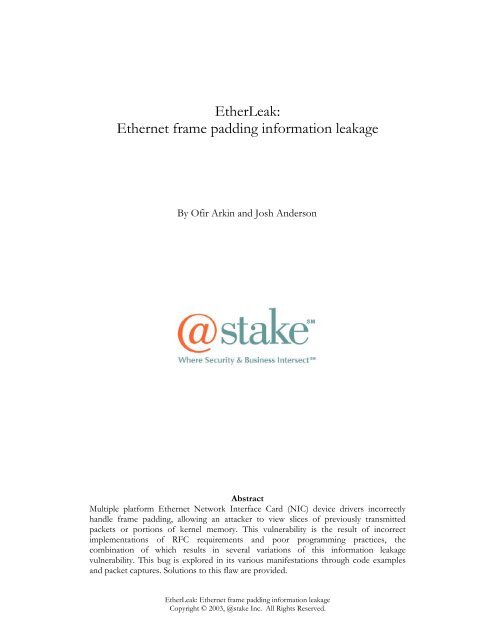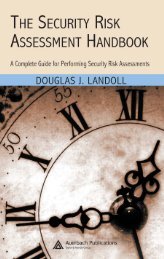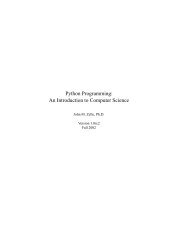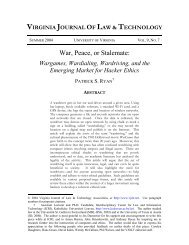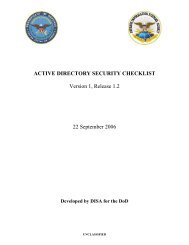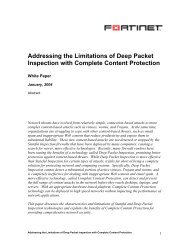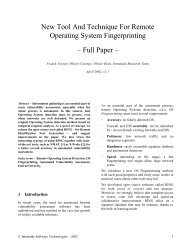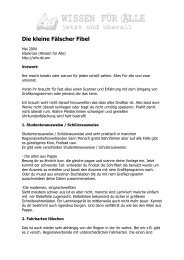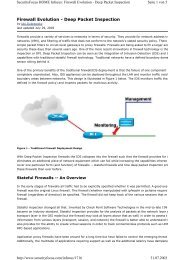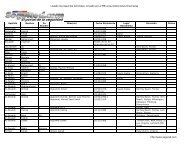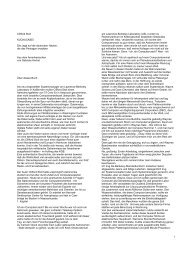EtherLeak: Ethernet Frame Padding Information ... - Leet Upload
EtherLeak: Ethernet Frame Padding Information ... - Leet Upload
EtherLeak: Ethernet Frame Padding Information ... - Leet Upload
Create successful ePaper yourself
Turn your PDF publications into a flip-book with our unique Google optimized e-Paper software.
<strong>EtherLeak</strong>:<br />
<strong>Ethernet</strong> frame padding information leakage<br />
By Ofir Arkin and Josh Anderson<br />
Abstract<br />
Multiple platform <strong>Ethernet</strong> Network Interface Card (NIC) device drivers incorrectly<br />
handle frame padding, allowing an attacker to view slices of previously transmitted<br />
packets or portions of kernel memory. This vulnerability is the result of incorrect<br />
implementations of RFC requirements and poor programming practices, the<br />
combination of which results in several variations of this information leakage<br />
vulnerability. This bug is explored in its various manifestations through code examples<br />
and packet captures. Solutions to this flaw are provided.<br />
<strong>EtherLeak</strong>: <strong>Ethernet</strong> frame padding information leakage<br />
Copyright © 2003, @stake Inc. All Rights Reserved.
2<br />
Contents<br />
1.0 Introduction..............................................................................................................................3<br />
2.0 A Brief Introduction to <strong>Ethernet</strong>..........................................................................................4<br />
2.1 History ..................................................................................................................................4<br />
2.2 <strong>Ethernet</strong> <strong>Frame</strong>s..................................................................................................................4<br />
2.3 Interfacing TCP/IP with <strong>Ethernet</strong> <strong>Frame</strong>s.....................................................................5<br />
3.0 The <strong>Ethernet</strong> <strong>Frame</strong> <strong>Padding</strong> Bug ........................................................................................6<br />
3.1 Theory...................................................................................................................................6<br />
3.2 Dynamic Kernel Buffer......................................................................................................7<br />
3.2.1 Driver Code..................................................................................................................7<br />
3.2.2 <strong>Frame</strong> Capture .............................................................................................................8<br />
3.3 Static Device Driver Buffer ...............................................................................................9<br />
3.3.1 Driver Code..................................................................................................................9<br />
3.3.2 <strong>Frame</strong> Capture ...........................................................................................................10<br />
3.4 Hardware Device Transmit Buffer.................................................................................11<br />
3.4.1 Driver Code................................................................................................................12<br />
3.4.2 <strong>Frame</strong> Capture ...........................................................................................................14<br />
4.0 Conclusion..............................................................................................................................15<br />
5.0 Acknowledgment...................................................................................................................16<br />
6.0 References...............................................................................................................................16<br />
Appendix A: Examples of Vulnerable Device Drivers ..........................................................17<br />
<strong>EtherLeak</strong>: <strong>Ethernet</strong> frame padding information leakage<br />
Copyright © 2003, @stake Inc. All Rights Reserved.
1.0 Introduction<br />
A link layer implementation flaw in multiple platforms allows an attacker to view slices of<br />
previously transmitted packets or portions of kernel memory. This vulnerability arises<br />
when bytes used to pad an <strong>Ethernet</strong> frame to the minimum size are copied directly from<br />
a dirty buffer without being sanitized. This information leakage vulnerability is trivial to<br />
exploit and has potentially devastating consequences. Several different variants of this<br />
implementation flaw result in this vulnerability; all of them will be examined in depth<br />
within this paper. The Linux, NetBSD and Microsoft Windows operating systems are<br />
known to have vulnerable link layer implementations and it is extremely likely that other<br />
operating systems are also affected.<br />
The <strong>Ethernet</strong> standards impose strict limitations on the size of encapsulated packets,<br />
requiring small packets to be padded up to a minimum size. Many device drivers<br />
responsible for <strong>Ethernet</strong> frame generation incorrectly handle the padding of small<br />
packets. They use data from the end of the frame manipulation buffer without initializing<br />
it to zero as required by the RFCs. The location of the buffer containing the frame<br />
determines the contents of the padding bytes.<br />
The next sections provide a brief introduction to <strong>Ethernet</strong> and <strong>Ethernet</strong> frames.<br />
Following this is a detailed examination of the flaw utilizing examples, focusing on the<br />
various implementations of this bug. Finally, solutions and areas of suggested further<br />
investigation will be presented.<br />
<strong>EtherLeak</strong>: <strong>Ethernet</strong> frame padding information leakage<br />
Copyright © 2003, @stake Inc. All Rights Reserved.<br />
3
4<br />
2.0 A Brief Introduction to <strong>Ethernet</strong><br />
This section provides a brief introduction to <strong>Ethernet</strong>, outlining the protocol’s history,<br />
the data transmission structures and how they interface with higher layer protocols.<br />
2.1 History<br />
<strong>Ethernet</strong> was first developed at Xerox labs in Palo Alto, California, in 1973. Seven years<br />
later the DEC-Intel-Xerox (DIX) consortium, formed to standardize and commercialize<br />
<strong>Ethernet</strong> technology, published the first 10Mbps <strong>Ethernet</strong> standard. This standard is<br />
commonly referred so as “<strong>Ethernet</strong> version I”, and a revision of the standard, published<br />
in 1982, is referred to as “<strong>Ethernet</strong> version II”. This last version of the standard is<br />
frequently referred to as the “DIX <strong>Ethernet</strong> Standard”. In 1985 the IEEE published<br />
“Carrier Sense Multiple Access with Collision Detection Access Method and Physical<br />
Layer Specifications”, better known as the 802.3 CSMA/CD standard. Based on the DIX<br />
<strong>Ethernet</strong> standard the IEEE 802.3 standard is currently the official <strong>Ethernet</strong> standard.<br />
Although adding a number of technical changes, the 802.3 standard remains backward<br />
compatible with the original DIX <strong>Ethernet</strong> standard. Since publishing 802.3 the IEEE<br />
has standardized a number of <strong>Ethernet</strong> related technologies such as 100Mbps Fast<br />
<strong>Ethernet</strong>, Gigabit <strong>Ethernet</strong> and others.<br />
2.2 <strong>Ethernet</strong> <strong>Frame</strong>s<br />
<strong>Ethernet</strong> is a link layer protocol used to transmit higher layer protocols between hosts.<br />
Data transition across the <strong>Ethernet</strong> is formed of discrete streams of bits, called frames.<br />
These frames must conform to one of two formats defined within the 802.3 standard.<br />
<strong>Frame</strong> formats enable a receiving system to correctly interpret a bit stream from the<br />
<strong>Ethernet</strong> as intelligible data organized into sections, called fields. Despite technical<br />
differences between the two formats they share several common fields. These fields<br />
provide some protection against data loss, detail the origin and destination of the frame,<br />
contain the encapsulated data and provide other important information.<br />
The data field is a variable length buffer that contains the encapsulated higher-layer<br />
packet being transmitted by the frame over the <strong>Ethernet</strong>. Restrictions within the<br />
<strong>Ethernet</strong> standards limit the size of this field to a minimum of 46 bytes and a maximum<br />
of 1500 bytes. If the higher level protocol data is less than the minimum it must be<br />
padded to the correct size.<br />
The two frame formats differ primarily in the mechanism they use to describe their<br />
encapsulated data, which gives rise to their names “Type encapsulation” and “Length<br />
encapsulation”. The Type encapsulation format describes the contents of its data field by<br />
the type of the higher layer protocol packet it encapsulates. The Length encapsulation<br />
format describes the length of the data field, and uses an optional LLC header to<br />
describe the higher layer protocol type.<br />
<strong>EtherLeak</strong>: <strong>Ethernet</strong> frame padding information leakage<br />
Copyright © 2003, @stake Inc. All Rights Reserved.
2.3 Interfacing TCP/IP with <strong>Ethernet</strong> <strong>Frame</strong>s<br />
The encapsulation of IP packets for transmission over <strong>Ethernet</strong> networks is defined in<br />
two RFCs. RFC 894[1], “A Standard for the Transmission of IP Datagrams over<br />
<strong>Ethernet</strong> Networks”, defines the encapsulation of IP packets for the DIX <strong>Ethernet</strong><br />
standard and RFC 1042[2], “A Standard for the Transmission of IP Datagrams over<br />
IEEE 802 Networks”, defines the encapsulation of IP packets for IEEE 802 networks.<br />
Both RFCs provide instructions on how to handle IP packets smaller than the minimum<br />
data field size (46 bytes) required by the <strong>Ethernet</strong> standards. They require that “the data<br />
field should be padded (with octets of zero) to meet the <strong>Ethernet</strong> minimum frame size”.<br />
This padding is not part of the IP packet and should not be included in the total length<br />
field of the IP header; it is simply part of the link-layer.<br />
Ambiguities within the RFCs leave it unclear as to who is responsible for padding the<br />
<strong>Ethernet</strong> frames; as such it is implementation dependent. Various different systems have<br />
implemented this padding operation in places such as the network interface card<br />
hardware (“auto padding”), the software device driver and even in a separate layer 2<br />
stack. Several implementation flaws have been discovered in the padding functionality of<br />
many device drivers. These flaws will be examined in the following section.<br />
<strong>EtherLeak</strong>: <strong>Ethernet</strong> frame padding information leakage<br />
Copyright © 2003, @stake Inc. All Rights Reserved.<br />
5
6<br />
3.0 The <strong>Ethernet</strong> <strong>Frame</strong> <strong>Padding</strong> Bug<br />
This section will examine the programming error behind the bug. The effects of each<br />
variation of this error will be analyzed through examples of offending code and frame<br />
captures originating from vulnerable drivers. Before delving into complex device driver<br />
code a generic example of the bug will be examined to clearly demonstrate the core<br />
programming mistake.<br />
3.1 Theory<br />
The following example presents the basic programming error which causes this<br />
information leakage vulnerability.<br />
01 void xmit_frame(char *frame_buf, int frame_len)<br />
02 {<br />
03 int length;<br />
04<br />
05<br />
06 if (frame_len < MIN_FRAME_SZ)<br />
07 length = MIN_FRAME_SZ;<br />
08 else<br />
09 length = frame_len;<br />
10<br />
11 copy_to_tx_buf(frame_buf, length);<br />
12<br />
13 return;<br />
14 }<br />
The function xmit_frame() takes two parameters, the first is a buffer containing the<br />
frame to be transmitted, and the second contains the length of the frame within the<br />
buffer. The code performs checks to ensure that the frame meets the minimum length<br />
requirements of the <strong>Ethernet</strong> standards (line 06). If the length is less than this minimum<br />
then length is initialized to the minimum (line 07), otherwise length is assigned the<br />
actual frame length from frame_len (line 09). The value of length is used to copy the<br />
frame buffer out to the transmit buffer on the network device (line 11). At this point an<br />
undersized transmitted frame will be padded, from frame_len to length, with the<br />
previous contents of the buffer. This vestigial data is the source of the information<br />
leakage.<br />
The fix for this example code, and indeed the majority of the affected code, is simply an<br />
additional line to zero out any padding bytes. An example solution is given below.<br />
...<br />
06 if (frame_len < MIN_FRAME_SZ) {<br />
07 length = MIN_FRAME_SZ;<br />
08 memset(frame_buf + frame_len, 0, length - frame_len);<br />
09 } else<br />
...<br />
<strong>EtherLeak</strong>: <strong>Ethernet</strong> frame padding information leakage<br />
Copyright © 2003, @stake Inc. All Rights Reserved.
This example code makes the programming mistake obvious to even a non-programmer,<br />
but, surprisingly, many production device drivers contain similarly flawed code. The error<br />
is essentially the same for all of the code examined during the writing of this paper, but<br />
its effects differ depending on the location of the buffer containing the frame prior to<br />
transmission. There are basically three potential buffer locations from which the pad<br />
bytes can originate:<br />
Dynamic kernel buffer<br />
Static device driver buffer<br />
Hardware device transmit buffer<br />
This section examines each of these.<br />
Please note in the following code examples only the relevant lines have been numbered,<br />
and although the authors refer to ETH_ZLEN as the minimum <strong>Ethernet</strong> frame size its<br />
value is in fact implementation dependent. Different devices provide different services<br />
for outgoing frames and their corresponding drivers behave accordingly.<br />
3.2 Dynamic Kernel Buffer<br />
<strong>Ethernet</strong> frames are typically constructed around an encapsulated higher layer protocol<br />
packet. These packets are built by the kernel TCP/IP stack and are manipulated within<br />
buffers allocated for this purpose. This example is from the Linux 2.4.18 kernel which<br />
uses a single buffer per packet. The buffer is dynamically allocated from kernel memory<br />
when required and thus its contents, if not initialized, will contain vestigial data from the<br />
kernel memory pool.<br />
3.2.1 Driver Code<br />
/usr/src/linux/drivers/net/atp.c 1 :<br />
static int atp_send_packet(struct sk_buff *skb, struct net_device *dev)<br />
{<br />
struct net_local *lp = (struct net_local *)dev->priv;<br />
long ioaddr = dev->base_addr;<br />
int length;<br />
long flags;<br />
01 length = ETH_ZLEN < skb->len ? skb->len : ETH_ZLEN;<br />
netif_stop_queue(dev);<br />
/* Disable interrupts by writing 0x00 to the Interrupt Mask Register.<br />
This sequence must not be interrupted by an incoming packet. */<br />
spin_lock_irqsave(&lp->lock, flags);<br />
write_reg(ioaddr, IMR, 0);<br />
write_reg_high(ioaddr, IMR, 0);<br />
spin_unlock_irqrestore(&lp->lock, flags);<br />
1 atp.c is a Linux device driver for <strong>Ethernet</strong> adapters based on the RealTek RTL8002 and RTL8012<br />
chipsets.<br />
<strong>EtherLeak</strong>: <strong>Ethernet</strong> frame padding information leakage<br />
Copyright © 2003, @stake Inc. All Rights Reserved.<br />
7
8<br />
02 write_packet(ioaddr, length, skb->data, dev->if_port);<br />
}<br />
lp->pac_cnt_in_tx_buf++;<br />
if (lp->tx_unit_busy == 0) {<br />
trigger_send(ioaddr, length);<br />
lp->saved_tx_size = 0; /* Redundant */<br />
lp->re_tx = 0;<br />
lp->tx_unit_busy = 1;<br />
} else<br />
lp->saved_tx_size = length;<br />
/* Re-enable the LPT interrupts. */<br />
write_reg(ioaddr, IMR, ISR_RxOK | ISR_TxErr | ISR_TxOK);<br />
write_reg_high(ioaddr, IMR, ISRh_RxErr);<br />
dev->trans_start = jiffies;<br />
dev_kfree_skb (skb);<br />
return 0;<br />
The skb structure contains a pointer to the frame construction buffer at skb->data and<br />
the size of the frame within that buffer at skb->len. The code at line 01 uses a C<br />
language construct to initialize length to the greater of the two size values: ETH_ZLEN or<br />
skb->len. Therefore, if the length of the frame is less than the <strong>Ethernet</strong> minimum<br />
(ETH_ZLEN) it will be rounded up to that minimum. The value of length is then used<br />
when copying the frame out from the skb->data buffer to the hardware device (line 02).<br />
The contents of the pad bytes is heavily dependent on system load. Due to the large<br />
address space of kernel memory and small number of pad bytes it is extremely unlikely<br />
that sensitive information will be leaked. However the origin of these pad bytes makes<br />
any such information potentially devastating.<br />
3.2.2 <strong>Frame</strong> Capture<br />
The following packet capture demonstrates how the contents of the pad bytes change as<br />
different portions of kernel memory are used for the construction of ICMP echo reply<br />
packets.<br />
14:18:48.146095 10.50.1.60 > 10.50.1.53: icmp: echo request (DF) (ttl<br />
64, id 0, len 29)<br />
4500 001d 0000 4000 4001 240c 0a32 013c<br />
0a32 0135 0800 83f9 5206 2200 00<br />
14:18:48.146393 10.50.1.53 > 10.50.1.60: icmp: echo reply (ttl 255,<br />
id 3747, len 29)<br />
4500 001d 0ea3 0000 ff01 9668 0a32 0135<br />
0a32 013c 0000 8bf9 5206 2200 0059 0100<br />
6c02 0000 c006 0000 0600 0000 0010<br />
14:18:49.146095 10.50.1.60 > 10.50.1.53: icmp: echo request (DF) (ttl<br />
64, id 0, len 29)<br />
4500 001d 0000 4000 4001 240c 0a32 013c<br />
0a32 0135 0800 82f9 5206 2300 00<br />
14:18:49.146387 10.50.1.53 > 10.50.1.60: icmp: echo reply (ttl 255,<br />
id 3749, len 29)<br />
4500 001d 0ea5 0000 ff01 9666 0a32 0135<br />
0a32 013c 0000 8af9 5206 2300 0000 4003<br />
2300 4003 f101 1200 ed01 feff 0000<br />
<strong>EtherLeak</strong>: <strong>Ethernet</strong> frame padding information leakage<br />
Copyright © 2003, @stake Inc. All Rights Reserved.
14:18:50.146093 10.50.1.60 > 10.50.1.53: icmp: echo request (DF) (ttl<br />
64, id 0, len 29)<br />
4500 001d 0000 4000 4001 240c 0a32 013c<br />
0a32 0135 0800 81f9 5206 2400 00<br />
14:18:50.146396 10.50.1.53 > 10.50.1.60: icmp: echo reply (ttl 255,<br />
id<br />
3751, len 29)<br />
4500 001d 0ea7 0000 ff01 9664 0a32 0135<br />
0a32 013c 0000 89f9 5206 2400 0000 8002<br />
1700 e002 1700 4003 9101 c001 0600<br />
3.3 Static Device Driver Buffer<br />
Some device drivers copy frames into internal buffers prior to sending them to the<br />
network card. The reasons for doing this vary from card to card. This example code for<br />
Linux 2.4 uses an alignment buffer to ensure that the frame buffer’s address is digestible<br />
by the card’s hardware. The RealTek 8139 chipset requires that the address of the buffer<br />
be aligned on a 32-bit word boundary. Because this reusable alignment buffer is not<br />
cleaned between uses, the contents of the previous occupant will be inadvertently used as<br />
pad bytes.<br />
3.3.1 Driver Code<br />
ftp://www.scyld.com/pub/network/test/rtl8139.c: 2<br />
static int<br />
rtl8129_start_xmit(struct sk_buff *skb, struct net_device *dev)<br />
{<br />
struct rtl8129_private *tp = (struct rtl8129_private *)dev->priv;<br />
long ioaddr = dev->base_addr;<br />
int entry;<br />
*/<br />
if (netif_pause_tx_queue(dev) != 0) {<br />
/* This watchdog code is redundant with the media monitor timer.<br />
}<br />
if (jiffies - dev->trans_start > TX_TIMEOUT)<br />
rtl8129_tx_timeout(dev);<br />
return 1;<br />
/* Calculate the next Tx descriptor entry. */<br />
entry = tp->cur_tx % NUM_TX_DESC;<br />
tp->tx_skbuff[entry] = skb;<br />
01 if ((long)skb->data & 3) { /* Must use alignment buffer. */<br />
02 memcpy(tp->tx_buf[entry], skb->data, skb->len);<br />
03 outl(virt_to_bus(tp->tx_buf[entry]), ioaddr + TxAddr0 +<br />
entry*4);<br />
04 } else<br />
05 outl(virt_to_bus(skb->data), ioaddr + TxAddr0 + entry*4);<br />
/* Note: the chip doesn't have auto-pad! */<br />
06 outl(tp->tx_flag | (skb->len >= ETH_ZLEN ? skb->len : ETH_ZLEN),<br />
ioaddr + TxStatus0 + entry*4);<br />
/* There is a race condition here -- we might read dirty_tx, take an<br />
2 rtl8139.c is a Linux device driver for the RealTek 8129/8139 chipsets.<br />
<strong>EtherLeak</strong>: <strong>Ethernet</strong> frame padding information leakage<br />
Copyright © 2003, @stake Inc. All Rights Reserved.<br />
9
10<br />
interrupt that clears the Tx queue, and only then set tx_full.<br />
So we do this in two phases. */<br />
if (++tp->cur_tx - tp->dirty_tx >= NUM_TX_DESC) {<br />
set_bit(0, &tp->tx_full);<br />
if (tp->cur_tx - (volatile unsigned int)tp->dirty_tx <<br />
NUM_TX_DESC) {<br />
clear_bit(0, &tp->tx_full);<br />
netif_unpause_tx_queue(dev);<br />
} else<br />
netif_stop_tx_queue(dev);<br />
} else<br />
netif_unpause_tx_queue(dev);<br />
dev->trans_start = jiffies;<br />
if (tp->msg_level & NETIF_MSG_TX_QUEUED)<br />
printk(KERN_DEBUG"%s: Queued Tx packet at %p size %d to slot<br />
%d.\n",<br />
dev->name, skb->data, (int)skb->len, entry);<br />
}<br />
return 0;<br />
The code here is similar to the previous example differing only in the check to ensure<br />
that the buffer containing the frame is properly aligned. If the address of the buffer is not<br />
aligned on a four byte boundary (line 01) then the frame will be copied to a buffer<br />
maintained by the device driver which is aligned (line 02). The address of the aligned<br />
buffer, either the driver’s alignment buffer (line 03) or the original buffer (line 05), is<br />
passed to the card. The card is informed of the address of the frame buffer and the<br />
length of the frame at line 06. The greater of the two values, ETH_ZLEN or skb->len, is<br />
passed to the card as the size of the frame to transmit (line 06).<br />
The pad bytes will always contain the contents of earlier packets and therefore present a<br />
great likelihood of revealing sensitive data.<br />
3.3.2 <strong>Frame</strong> Capture<br />
The following example was produced by a Linux 2.4.x machine with a Xircom PCMCIA<br />
network card using the xirc2ps_cs.c device driver.<br />
The following tcpdump traces clearly demonstrates the information leakage problem.<br />
The information leaked is HTTP-based traffic.<br />
14:49:09.306008 192.168.222.11 > 192.168.222.25: icmp: echo reply (DF) (ttl<br />
128, id 577, len 28)<br />
0x0000 4500 001c 0241 4000 8001 bb29 c0a8 de0b E....A@....)....<br />
0x0010 c0a8 de19 0000 48f9 b406 0300 0400 0000 ......H.........<br />
0x0020 0004 0650 5542 4c49 4303 4e4c 5307 ...PUBLIC.NLS.<br />
14:50:46.313706 192.168.222.11 > 192.168.222.25: icmp: echo reply (DF) (ttl<br />
128, id 854, len 28)<br />
0x0000 4500 001c 0356 4000 8001 ba14 c0a8 de0b E....V@.........<br />
0x0010 c0a8 de19 0000 e7f8 b406 6400 4b43 4c41 ..........d.KCLA<br />
0x0020 4e47 2e44 4c4c 3c00 0090 2787 ce24 NG.DLL
14:51:11.315842 192.168.222.11 > 192.168.222.25: icmp: echo reply (DF) (ttl<br />
128, id 895, len 28)<br />
0x0000 4500 001c 037f 4000 8001 b9eb c0a8 de0b E.....@.........<br />
0x0010 c0a8 de19 0000 cef8 b406 7d00 743a 204d ..........}.t:.M<br />
0x0020 6f7a 696c 6c61 2f35 2e30 2028 5769 ozilla/5.0.(Wi<br />
14:51:50.318904 192.168.222.11 > 192.168.222.25: icmp: echo reply (DF) (ttl<br />
128, id 1435, len 28)<br />
0x0000 4500 001c 059b 4000 8001 b7cf c0a8 de0b E.....@.........<br />
0x0010 c0a8 de19 0000 a7f8 b406 a400 6b65 6570 ............keep<br />
0x0020 2d61 6c69 7665 0d0a 436f 6f6b 6965 -alive..Cookie<br />
14:51:51.319076 192.168.222.11 > 192.168.222.25: icmp: echo reply (DF) (ttl<br />
128, id 1436, len 28)<br />
0x0000 4500 001c 059c 4000 8001 b7ce c0a8 de0b E.....@.........<br />
0x0010 c0a8 de19 0000 a6f8 b406 a500 434f 500d ............COP.<br />
0x0020 0a52 6566 6572 6572 3a20 6874 7470 .Referer:.http<br />
14:52:03.320000 192.168.222.11 > 192.168.222.25: icmp: echo reply (DF) (ttl<br />
128, id 1449, len 28)<br />
0x0000 4500 001c 05a9 4000 8001 b7c1 c0a8 de0b E.....@.........<br />
0x0010 c0a8 de19 0000 9af8 b406 b100 2057 696e .............Win<br />
0x0020 646f 7773 204e 5420 352e 303b 2065 dows.NT.5.0;.e<br />
14:52:04.320125 192.168.222.11 > 192.168.222.25: icmp: echo reply (DF) (ttl<br />
128, id 1450, len 28)<br />
0x0000 4500 001c 05aa 4000 8001 b7c0 c0a8 de0b E.....@.........<br />
0x0010 c0a8 de19 0000 99f8 b406 b200 2f78 6d6c ............/xml<br />
0x0020 2c61 7070 6c69 6361 7469 6f6e 2f78 ,application/x<br />
14:52:05.320151 192.168.222.11 > 192.168.222.25: icmp: echo reply (DF) (ttl<br />
128, id 1451, len 28)<br />
0x0000 4500 001c 05ab 4000 8001 b7bf c0a8 de0b E.....@.........<br />
0x0010 c0a8 de19 0000 98f8 b406 b300 742f 706c ............t/pl<br />
0x0020 6169 6e3b 713d 302e 382c 7669 6465 ain;q=0.8,vide<br />
14:52:06.320274 192.168.222.11 > 192.168.222.25: icmp: echo reply (DF) (ttl<br />
128, id 1452, len 28)<br />
0x0000 4500 001c 05ac 4000 8001 b7be c0a8 de0b E.....@.........<br />
0x0010 c0a8 de19 0000 97f8 b406 b400 2c74 6578 ............,tex<br />
0x0020 742f 6373 732c 2a2f 2a3b 713d 302e t/css,*/*;q=0.<br />
14:52:07.320319 192.168.222.11 > 192.168.222.25: icmp: echo reply (DF) (ttl<br />
128, id 1453, len 28)<br />
0x0000 4500 001c 05ad 4000 8001 b7bd c0a8 de0b E.....@.........<br />
0x0010 c0a8 de19 0000 96f8 b406 b500 677a 6970 ............gzip<br />
0x0020 2c20 6465 666c 6174 652c 2063 6f6d ,.deflate,.com<br />
14:52:08.320393 192.168.222.11 > 192.168.222.25: icmp: echo reply (DF) (ttl<br />
128, id 1455, len 28)<br />
0x0000 4500 001c 05af 4000 8001 b7bb c0a8 de0b E.....@.........<br />
0x0010 c0a8 de19 0000 95f8 b406 b600 436f 6f6b ............Cook<br />
0x0020 6965 3a20 4153 5053 4553 5349 4f4e ie:.ASPSESSION<br />
14:52:09.320478 192.168.222.11 > 192.168.222.25: icmp: echo reply (DF) (ttl<br />
128, id 1456, len 28)<br />
0x0000 4500 001c 05b0 4000 8001 b7ba c0a8 de0b E.....@.........<br />
0x0010 c0a8 de19 0000 94f8 b406 b700 3a20 6874 ............:.ht<br />
0x0020 7470 3a2f 2f77 7777 2e63 7279 7374 tp://www.cryst<br />
3.4 Hardware Device Transmit Buffer<br />
Some device drivers contain a particularly severe variation of this bug in which they<br />
incorrectly inform the card of the number of bytes which have been placed into the<br />
hardware transmit buffer. When this happens, the padding bytes are supplied by the<br />
contents of the previous frame occupying that space. The Linux 2.4 axnet_cs.c device<br />
driver demonstrates just such a variant. The code incorrectly informs the device that the<br />
minimum number of bytes have been copied out to the Tx buffer, when in fact the actual<br />
length of the frame is all that has been supplied. The card will transmit the length it has<br />
been informed of, and thus send bytes from its Tx buffer as frame padding.<br />
<strong>EtherLeak</strong>: <strong>Ethernet</strong> frame padding information leakage<br />
Copyright © 2003, @stake Inc. All Rights Reserved.<br />
11
12<br />
3.4.1 Driver Code<br />
/usr/src/linux/drivers/net/pcmcia/axnet_cs.c 3 :<br />
static int ei_start_xmit(struct sk_buff *skb, struct net_device *dev)<br />
{<br />
long e8390_base = dev->base_addr;<br />
struct ei_device *ei_local = (struct ei_device *) dev->priv;<br />
int length, send_length, output_page;<br />
unsigned long flags;<br />
netif_stop_queue(dev);<br />
01 length = skb->len;<br />
*/<br />
/* Mask interrupts from the ethercard.<br />
SMP: We have to grab the lock here otherwise the IRQ handler<br />
on another CPU can flip window and race the IRQ mask set. We end<br />
up trashing the mcast filter not disabling irqs if we dont lock<br />
spin_lock_irqsave(&ei_local->page_lock, flags);<br />
outb_p(0x00, e8390_base + EN0_IMR);<br />
spin_unlock_irqrestore(&ei_local->page_lock, flags);<br />
/*<br />
* Slow phase with lock held.<br />
*/<br />
disable_irq_nosync(dev->irq);<br />
spin_lock(&ei_local->page_lock);<br />
ei_local->irqlock = 1;<br />
02 send_length = ETH_ZLEN < length ? length : ETH_ZLEN;<br />
/*<br />
* We have two Tx slots available for use. Find the first free<br />
* slot, and then perform some sanity checks. With two Tx bufs,<br />
* you get very close to transmitting back-to-back packets. With<br />
* only one Tx buf, the transmitter sits idle while you reload the<br />
* card, leaving a substantial gap between each transmitted packet.<br />
*/<br />
if (ei_local->tx1 == 0)<br />
{<br />
output_page = ei_local->tx_start_page;<br />
03 ei_local->tx1 = send_length;<br />
if (ei_debug && ei_local->tx2 > 0)<br />
printk(KERN_DEBUG "%s: idle transmitter tx2=%d,<br />
lasttx=%d, txing=%d.\n",<br />
dev->name, ei_local->tx2, ei_local->lasttx, ei_local-<br />
>txing);<br />
}<br />
else if (ei_local->tx2 == 0)<br />
{<br />
output_page = ei_local->tx_start_page + TX_1X_PAGES;<br />
04 ei_local->tx2 = send_length;<br />
if (ei_debug && ei_local->tx1 > 0)<br />
printk(KERN_DEBUG "%s: idle transmitter, tx1=%d,<br />
lasttx=%d, txing=%d.\n",<br />
dev->name, ei_local->tx1, ei_local->lasttx,<br />
ei_local->txing);<br />
}<br />
3 axnet_cs.c is a Linux device driver for PCMCIA <strong>Ethernet</strong> cards based on the Asix88190 chipset.<br />
<strong>EtherLeak</strong>: <strong>Ethernet</strong> frame padding information leakage<br />
Copyright © 2003, @stake Inc. All Rights Reserved.
else<br />
{ /* We should never get here. */<br />
if (ei_debug)<br />
printk(KERN_DEBUG "%s: No Tx buffers free! tx1=%d<br />
tx2=%d last=%d\n",<br />
dev->name, ei_local->tx1, ei_local->tx2,<br />
ei_local->lasttx);<br />
ei_local->irqlock = 0;<br />
netif_stop_queue(dev);<br />
outb_p(ENISR_ALL, e8390_base + EN0_IMR);<br />
spin_unlock(&ei_local->page_lock);<br />
enable_irq(dev->irq);<br />
ei_local->stat.tx_errors++;<br />
return 1;<br />
}<br />
/*<br />
* Okay, now upload the packet and trigger a send if the transmitter<br />
* isn't already sending. If it is busy, the interrupt handler will<br />
* trigger the send later, upon receiving a Tx done interrupt.<br />
*/<br />
05 ei_block_output(dev, length, skb->data, output_page);<br />
if (! ei_local->txing)<br />
{<br />
ei_local->txing = 1;<br />
NS8390_trigger_send(dev, send_length, output_page);<br />
dev->trans_start = jiffies;<br />
if (output_page == ei_local->tx_start_page)<br />
{<br />
ei_local->tx1 = -1;<br />
ei_local->lasttx = -1;<br />
}<br />
else<br />
{<br />
ei_local->tx2 = -1;<br />
ei_local->lasttx = -2;<br />
}<br />
}<br />
else ei_local->txqueue++;<br />
}<br />
if (ei_local->tx1 && ei_local->tx2)<br />
netif_stop_queue(dev);<br />
else<br />
netif_start_queue(dev);<br />
/* Turn 8390 interrupts back on. */<br />
ei_local->irqlock = 0;<br />
outb_p(ENISR_ALL, e8390_base + EN0_IMR);<br />
spin_unlock(&ei_local->page_lock);<br />
enable_irq(dev->irq);<br />
dev_kfree_skb (skb);<br />
ei_local->stat.tx_bytes += send_length;<br />
return 0;<br />
The variable length is assigned the real length of the packet (line 01). The value of<br />
length is compared against the minimum frame length, and which ever is larger assigned<br />
to send_length (line 02). Depending on which of the two Tx buffers is free, the device<br />
<strong>EtherLeak</strong>: <strong>Ethernet</strong> frame padding information leakage<br />
Copyright © 2003, @stake Inc. All Rights Reserved.<br />
13
14<br />
is informed of the frame length at either line 03 or 04. However, at line 05 the actual<br />
length of the packet is used to copy the frame out to the device.<br />
The padding bytes will always contain data from previous frames transmitted by the<br />
device. This is potentially the most severe manifestation of this bug because the data<br />
contained in the padding bytes is always from one of the last packets transmitted.<br />
3.4.2 <strong>Frame</strong> Capture<br />
The following example was produced by a Linux 2.4.x machine with a PCMCIA network<br />
card using the axnet_cs.c device driver.<br />
The following tcpdump traces clearly demonstrates the information leakage problem.<br />
14:18:48.146095 10.50.1.60 > 10.50.1.53: icmp: echo request (DF) (ttl<br />
64, id 0, len 29)<br />
4500 001d 0000 4000 4001 240c 0a32 013c<br />
0a32 0135 0800 83f9 5206 2200 00<br />
14:18:48.146393 10.50.1.53 > 10.50.1.60: icmp: echo reply (ttl 255,<br />
id 3747, len 29)<br />
4500 001d 0ea3 0000 ff01 9668 0a32 0135<br />
0a32 013c 0000 8bf9 5206 2200 0059 0100<br />
6c02 0000 c006 0000 0600 0000 0010<br />
14:18:49.146095 10.50.1.60 > 10.50.1.53: icmp: echo request (DF) (ttl<br />
64, id 0, len 29)<br />
4500 001d 0000 4000 4001 240c 0a32 013c<br />
0a32 0135 0800 82f9 5206 2300 00<br />
14:18:49.146387 10.50.1.53 > 10.50.1.60: icmp: echo reply (ttl 255,<br />
id 3749, len 29)<br />
4500 001d 0ea5 0000 ff01 9666 0a32 0135<br />
0a32 013c 0000 8af9 5206 2300 0000 4003<br />
2300 4003 f101 1200 ed01 feff 0000<br />
14:18:50.146093 10.50.1.60 > 10.50.1.53: icmp: echo request (DF) (ttl<br />
64, id 0, len 29)<br />
4500 001d 0000 4000 4001 240c 0a32 013c<br />
0a32 0135 0800 81f9 5206 2400 00<br />
14:18:50.146396 10.50.1.53 > 10.50.1.60: icmp: echo reply (ttl 255,<br />
id 3751, len 29)<br />
4500 001d 0ea7 0000 ff01 9664 0a32 0135<br />
0a32 013c 0000 89f9 5206 2400 0000 8002<br />
1700 e002 1700 4003 9101 c001 0600<br />
<strong>EtherLeak</strong>: <strong>Ethernet</strong> frame padding information leakage<br />
Copyright © 2003, @stake Inc. All Rights Reserved.
4.0 Conclusion<br />
A flaw in the handling of <strong>Ethernet</strong> frame padding has been presented and examined in<br />
detail. This link layer implementation flaw is known to affect multiple platforms and is<br />
believed to affect many more. The nature of this vulnerability makes it beyond the means<br />
of the authors to test and verify this bug on more than a limited number of systems, and<br />
the release of this paper is intended to prompt vendors to test and patch their products.<br />
The number of affected systems is staggering, and the number of vulnerable systems<br />
used as critical network infrastructure terrifying. The security of proprietary network<br />
devices is particularly questionable. Just how secure is your VLAN?<br />
<strong>EtherLeak</strong>: <strong>Ethernet</strong> frame padding information leakage<br />
Copyright © 2003, @stake Inc. All Rights Reserved.<br />
15
16<br />
5.0 Acknowledgment<br />
On May 28, 2002 Ofir Arkin released a bug report[3] concerning a layer 2 representation<br />
bug with tcpdump. Shortly after the release of this advisory, the authors were contacted<br />
by Stealth and Skyper of Team TESO and George Bakos (gbakos@ists.dartmouth.edu)<br />
of Dartmouth College, who provided them with examples of the tcpdump bug<br />
demonstrating information leakage. An investigation instigated by these reported<br />
examples led to the discovery of the bug. Throughout the writing of this paper George<br />
Bakos has been instrumental in testing and providing examples of this vulnerability. As<br />
such, the authors gratefully acknowledge the contributions of the above individuals.<br />
Additionally, the authors would like to thank the following people for contributions of<br />
networks, hardware and time:<br />
Bill Scherr<br />
Jeff Dike<br />
Vermont Army National Guard - <strong>Information</strong> Operations<br />
6.0 References<br />
[1] RFC 894 is available from: http://www.ietf.org/rfc/rfc894.txt<br />
[2] RFC 1042 is available from: http://www.ietf.org/rfc/rfc1042.txt<br />
[3] http://www.sys-security.com/archive/bugtraq/ofirarkin2002-03.txt<br />
<strong>EtherLeak</strong>: <strong>Ethernet</strong> frame padding information leakage<br />
Copyright © 2003, @stake Inc. All Rights Reserved.
Appendix A: Examples of Vulnerable Device Drivers<br />
The following table lists some vulnerable device drivers from the Linux 2.4.18 Kernel.<br />
All device drivers can be found under /usr/src/linux/drivers/net/:<br />
Device Driver Original Description<br />
3c501.c A 3Com 3c501 <strong>Ethernet</strong> driver for Linux<br />
3c507.c An EtherLink16 device driver for Linux<br />
3c523.c net-3-driver for the 3c523 Etherlink/MC card (i82586 <strong>Ethernet</strong> chip)<br />
3c527.c 3com Etherlink/MC32 driver for Linux 2.4<br />
7990.c LANCE <strong>Ethernet</strong> IC generic routines (AMD 7990 LANCE, local area<br />
network controller for <strong>Ethernet</strong>)<br />
8139too.c RealTek RTL-8139 Fast <strong>Ethernet</strong> driver for Linux (based on<br />
rtl8139.c device driver which is also vulnerable) RTL 8129, 8139<br />
chipsets<br />
82596.c A generic 82596 <strong>Ethernet</strong> driver for Linux<br />
8390.c A general NS8390 <strong>Ethernet</strong> driver core for Linux<br />
a2065.c Amiga Linux/68k A2065 <strong>Ethernet</strong> Driver<br />
aironet4500_core.c Aironet 4500/4800 driver core<br />
am79c961a.c driver for the am79c961A Lance chip used in the Intel (formally<br />
Digital Equipment Corp) EBSA110 platform.<br />
ariadne.c Amiga Linux/m68k Ariadne <strong>Ethernet</strong> Driver<br />
arlan.c This module provides support for the Arlan 655 card made by<br />
Aironet<br />
at1700.c A network device driver for the Allied Telesis AT1700<br />
atari_bionet.c BioNet-100 device driver for linux68k<br />
atarilance.c <strong>Ethernet</strong> driver for VME Lance cards on the Atari<br />
atari_pamsnet.c PAMsNet device driver for linux68k<br />
atp.c Attached (pocket) <strong>Ethernet</strong> adapter driver for Linux (Realtek<br />
RTL8002 and RTL8012 chips)<br />
bagetlance.c <strong>Ethernet</strong> driver for VME Lance cards on Baget/MIPS<br />
declance.c Lance ethernet driver for the MIPS processor based DECstation<br />
family<br />
depca.c A DIGITAL DEPCA & EtherWORKS ethernet driver for Linux<br />
eepro.c Intel EtherExpress Pro/10 device driver for Linux<br />
eexpress.c Intel EtherExpress 16 device driver for Linux<br />
epic100.c A SMC 83c170 EPIC/100 Fast <strong>Ethernet</strong> driver for Linux (This driver<br />
is for the SMC83c170/175 “EPIC” series, as used on the SMC<br />
EtherPower II 9432 PCI adapter, and several CardBus cards)<br />
eth16i.c An ICL EtherTeam 16i and 32 EISA <strong>Ethernet</strong> driver for Linux<br />
fmv18x.c A network device driver for the Fujitsu FMV-181/182/183/184<br />
gmac.c Network device driver for the GMAC <strong>Ethernet</strong> controller on Apple G4<br />
Powermacs<br />
isa-skeleton.c A network driver outline for Linux<br />
lance.c An AMD LANCE/PCnet <strong>Ethernet</strong> driver for Linux<br />
lasi_82596.c Driver for the Intel 82596 <strong>Ethernet</strong> controller, as munged into HPPA<br />
boxen<br />
lp486e.c Panther 82596 <strong>Ethernet</strong> driver for Linux<br />
ni5010.c A network driver for the MiCom-Interlan NI5010 ethercard<br />
ni52.c net-3-driver for the NI5210 card (i82586 <strong>Ethernet</strong> chip)<br />
ni65.c ni6510 (am7990 'lance' chip) driver for Linux-net-3<br />
pci-skeleton.c This driver is for boards based on the RTL8129 and RTL8139 PCI<br />
<strong>Ethernet</strong> chips<br />
saa9730.c SAA9730 <strong>Ethernet</strong> driver<br />
seeq8005.c A network device driver for the SEEQ 8005 chipset<br />
sgiseeq.c Seeq8003 <strong>Ethernet</strong> driver for SGI machines<br />
sk_g16.c<br />
smc9194.c A driver for SMC's 9000 series of <strong>Ethernet</strong> cards<br />
sonic.c<br />
sun3lance.c<br />
<strong>EtherLeak</strong>: <strong>Ethernet</strong> frame padding information leakage<br />
Copyright © 2003, @stake Inc. All Rights Reserved.<br />
17
18<br />
Device Driver Original Description<br />
tc35815.c<br />
via-rhine.c A Linux <strong>Ethernet</strong> device driver for VIA Rhine family chips<br />
wavelan.c WaveLAN ISA driver<br />
znet.c An Zenith Z-Note <strong>Ethernet</strong> driver for Linux<br />
Table A.1: Some Vulnerable Linux Device Drivers<br />
The following table lists some vulnerable PCMCIA device drivers from the Linux 2.4.18<br />
Kernel which can be found under /usr/src/linux/drivers/net/pcmcia:<br />
Device Driver Original Description<br />
Wavelan_cs.c Supports version 2.00 of WaveLAN/PCMCIA cards (2.4GHz)<br />
xirc2ps_cs.c Xircom CreditCard <strong>Ethernet</strong> Adapter IIps driver<br />
Xircom Realport 10/100 (RE-100) driver.<br />
This driver supports various Xircom CreditCard <strong>Ethernet</strong> adapters<br />
including the CE2, CE IIps, RE-10, CEM28, CEM33, CE33, CEM56,<br />
CE3-100, CE3B, RE-100, REM10BT, and REM56G-100.<br />
Table A.2: Some Vulnerable PCMCIA Linux Device Drivers<br />
<strong>EtherLeak</strong>: <strong>Ethernet</strong> frame padding information leakage<br />
Copyright © 2003, @stake Inc. All Rights Reserved.


